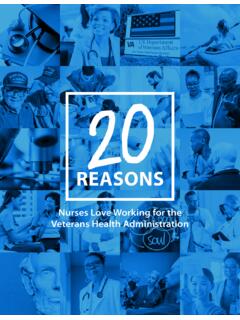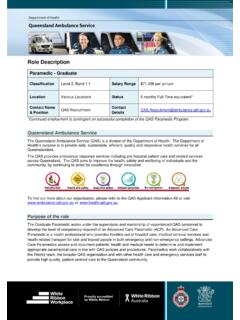Transcription of Scope of practice – framework for nurses and midwives
1 Scope of practice framework for nurses and midwivesRPPO05_0508 Approved by Council 2005 Amended June 2008 Next review 2010 Scope of practice framework for nurses and midwivesUpdated 2005 ContentsOverview and exclusions .. 3 Section A Role relationships of health care personnel ..6 Diagram 1: Map of role relationships among health care personnel ..6 Clients .. Licensed nurses and midwives ..6 Registered nurse (RN) ..6 Midwife ..7 Enrolled nurse (EN) ..7 nurse practitioner ..7 Other health professionals ..7 Unlicensed health care workers .. Aboriginal health workers and Torres Strait Islander health workers .. 7 Section B - Nursing and midwifery practice .. 8 Diagram 2: The continuum of Nursing and midwifery practice ..8 Scope of practice ..9 Key practice standards for RNs, ENs and midwives ..9 Table 1: Key professional practice standards .. The continuum of practice .
2 10 Section C The three sets of principles ..11 Diagram 3: Scope of practice of nurses and midwives .. 11 Set 1: Principles for advancing the Scope of practice of registered nurses , enrolled nurses and midwives .. 12 Set 2: Principles for expanding the Scope of practice of registered nurses and midwives ..13 Set 3: Principles for delegating to unlicenced health care workers (HCWs) .. 14 Section D Definitions .. Accountability and responsibility ..15 Activity ..15 Clients .. Competence /competent ..16 Consultation and planning ..16 Context of practice .. Delegation ..17 Table 2: Delegation summary .. Education ..18 Standards ..18 Supervision ..18 IntroductionThe Queensland Nursing Council (Council) is responsible for administering the Nursing Act 1992 (Queensland). Council s role is to help ensure safe and competent nursing and midwifery practice . One of Council s functions (Section 7(b) of the Nursing Act 1992) is to determine the Scope of practice for Queensland s nurses and midwives .
3 To fulfil this function, Council has developed the Scope of practice framework for nurses and midwives (The framework ).Do you need more detailed information, clarification or examples? Throughout this document icons point you to other sources of information: framework information sheets Website and case studiesScope of practice framework for nurses and midwivesUpdated 20053 nurses and midwives Scope of practice The Scope of practice for nurses and midwives cannot be defined as a simple list of tasks or procedures. In rapidly evolving health care environments, nurses and midwives must frequently incorporate new knowledge and skills into their practice . Therefore, a list of approved activities would quickly become out of date. The framework s more sustainable approach of providing a broad, principle-based definition, allows individual nurses and midwives in any setting to reflect on their current Scope of practice by comparing it with the definition Scope of nursing and midwifery practice is that which nurses and midwives are educated, competent and authorised to perform.
4 The actual Scope of an individual nurse s or midwife s practice is influenced by the: context in which they practice clients health needs level of competence, education and qualifications of the individual nurse or midwife service providers information in the FrameworkThe framework also explains: nurses and midwives accountabilities and responsibilities in relation to delegated activities how nurses and midwives maximise their contribution to client care by contributing to the professional development of others and by developing their own careers the decision-making process that RNs and midwives use (Set 3) when they delegate care activities to unlicensed health care workers (HCWs).Overview and exclusionsSince its first release in 1998, the Scope of practice framework for nurses and midwives ( framework ) has proven to be a valid, reliable and useful decision-making tool. In this 2005 version, greater emphasis has been placed on the: central role clients play in any Scope of practice decision differences in the roles and responsibilities of health care team members importance of professional competency standards benefits of collaboration and framework acknowledges the professionalism of nurses and midwives To help ensure safe and competent practice , all Australian nurses and midwives must hold a licence.
5 To obtain this annual licence, each applicant must meet levels of competence that are equivalent to the Australian core competency standards. In Queensland, the framework , used as a decision-making tool, builds on these competency standards because it enables the profession, in collaboration with health service providers, to advance or expand nurses and midwives Scope of practice in a planned and structured and midwives are widely respected health care providers, combining education and professionalism with a caring concern for clients. The framework complements the key professional characteristics of accountability for practice , advocacy, autonomy and collaboration . In particular, it supports professional accountability when each individual uses their professional discretion to make Scope of practice confidence Clients and health service providers can be confident that the decisions nurses and midwives make using the framework will result in the maintenance of the high standard of care that clients expect from the professions.
6 Any changes in a nurse s or midwife s Scope of practice must primarily be aimed at meeting clients health needs. For example: An enrolled nurse (EN) using the Principles for advancing the Scope of practice of RNs, ENs and midwives , (Set 1) can safely accept a delegation that advances their Scope of practice to meet an individual client s health needs A registered nurse (RN) or midwife using the Principles for expanding the Scope of practice of registered nurses and midwives (Set 2), can incorporate a new health service into their Scope of practice to provide clients with better access to health of practice framework for nurses and midwivesUpdated 20054 Exclusions - when the framework does not applyA nurse or midwife can use the relevant principles to determine what activities or tasks they can delegate or accept. But, in the following circumstances the framework should not be Actions in an emergencyNothing in this document can be construed as preventing a nurse , midwife or other person from taking appropriate action in an emergency.
7 Activities that a registered nurse or midwife cannot delegateCouncil has excluded some nursing and midwifery activities from the framework s decision-making processes and allocated these activities (see A, B, C below) to the sole domain of RNs or midwives . When determining what should be excluded, Council considered that: RNs and midwives making practice decisions have more autonomy than ENs. ENs contribute to care planning but may not act independently because the RN or midwife retains overall responsibility. For example, when ENs accept a delegation, they may not re-delegate that activity to another person. This is because RNs and midwives are responsible for ensuring the quality of the work through their involvement in teaching, competence assessment, supervision and the evaluation of clients outcomes. the national competency standards give certain responsibilities exclusively to RNs and midwives the Nursing Act 1992 contains some practice restrictions (detailed in section C below).
8 The following activities (A, B, C) cannot be delegated to people who are not RNs or midwives : A) Care planning and delegation of activities from a nursing/midwifery care plan i. The comprehensive assessment of individuals and The interpretation of assessment data. iii. The formulation and documentation of a plan of care including establishing the priorities of The evaluation of client responses and other information, for the purposes of making changes to the care The responsibility for the delegation to others of activities from the nursing or midwifery care midwife must not delegate the responsibility for midwifery care planning to any person who is not a midwife. RNs or ENs undertaking activities delegated to them from a midwifery care plan must work with the support and supervision of a midwife. An RN must not delegate the responsibility for nursing care planning to any person who is not an RN.
9 Direct-entry midwives or ENs undertaking activities delegated to them from a nursing care plan must work with the support and supervision of an RN. B) Some aspects of drug administration by ENsThe Health (Drugs and Poisons) Regulations 1996 authorises certain individuals to administer, prescribe or supply Council s website for information on: delegation and clinically-focused ) Legislated practice restrictions The Nursing Act 1992 includes the following restricted practice provisions (amendments 2005): Practising nursing is restricted to registered and enrolled nurses and others who are authorised to practise nursing by Council (Section 77H). Caring for women in childbirth1 is a practice restricted to midwives (authorised by Council). (Section 77I) Council may prosecute individuals for unauthorised (unlicensed) nursing practice or for caring for a woman in childbirth without being authorised as a midwife.
10 There are some exceptions listed in the Nursing Act and midwifery practice cannot be defined as a simple list of tasks. Therefore, Council will consider every case of alleged unauthorised practice on its own merits. When making a decision on what is unauthorised practice , Council may take into account the: practice restrictions in the Act information contained within this document Scope of practice framework for nurses and midwives client s needs and expectations nature of the activity context of the alleged breach, including client outcomes and the organisational environment responsibilities and actions of any nurse or midwife involved in the Council s website for information on: nursing practice restrictions midwifery practice Childbirth is defined in the Nursing Act 1992 as the process of labour and delivery beginning with uterine contractions and ending with the expulsion of the placenta and membranes from the woman giving of practice framework for nurses and midwivesUpdated 20055 Responsibility for using the framework in team care settingsIn team care settings2, it is important for each nurse or midwife to establish if they are responsible for the care or activities carried out by others.


















